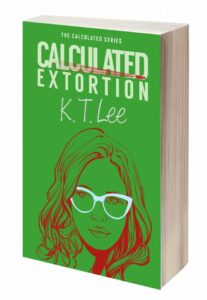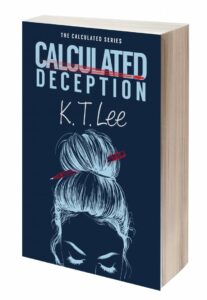
Having self-published three books in one go, KT Lee's even convinced her puppy to do things in threes
We all know that one of the big temptations as a self-publishing author is to publish too soon, before our books are the best they can be, simply because the technology makes it so easy to launch a book at the touch of a button. But could you muster enough patience to wait till you've written two more books before you publish the first? If you're writing a series, holding back till you've got the first three books ready to roll can be a real winner, marketing-wise. K T Lee is joining us today to explain how and why she did just that with her new Calculated series. Her thoughtful list of the pros and cons of her approach will help you decide the best course of action for your books.
Why I Waited to Publish Until I'd Written Three Books

Book 0 in KT Lee's Calculated series (the free prequel novella)
It’s a bit unconventional, I know. To write a book you intend to publish and then hang onto it. For years, even. However, before I even finished writing Calculated Deception, I knew I wanted my characters’ story to extend beyond one book.
- In traditional publishing, this is a huge no-no – planning for future books before your first one has sold is putting the cart before the horse, and all of that.
- In indie publishing, releasing a series is highly recommended.
As a debut author, I decided to wait until I had three books written before launching my series. I can’t tell you what will work best for you and your novels, but I can share a few pros and cons of this approach that I’ve learned along the way.
Pros and Cons of Launching the First Three Books in a Series

Book 1 in KT Lee's Calculated series
Investment:
- Pros: Writing a series forced me to come into the world of publishing with a business plan and marketing strategy. One unspoken reason writers don’t become indie authors is the start-up cost of turning a manuscript into a book. While uploading is free, the services you will likely need to produce a professional product are not. Editing, copyright, cover design, ISBNs, formatting (oh my!).
- Cons: I had much higher start-up costs than an author releasing one book. However, I was able to release a free prequel novella with the knowledge I had two books right behind it, ready for readers who enjoyed the free book.
- Editing:
- Pros: When I realized I wanted to change something about a character in a previous book, I could go back and fix it. Minor plothole repair, we’ll call it, for fellow pun-addicted authors.
- Cons: The endless ability to edit books that are “done” means that it can be hard to stop tinkering with the prose.

Book 2 in KT Lee's Calculated series
Cover design/formatting:
- Pros: Volume discounts, consistency, expediency. Ripping off the proverbial band-aid! Getting to see three books that all work together on your author page, right away.
- Cons: Great cover design is hard, ya’ll. That’s why I left it to a professional who helped shape my blurry vision into a beautiful product. However, it was an extra challenge to make three distinct covers that all played nice together. I formatted the interior of the book, which meant I had all the headaches that come along with formatting, times three. Using a template helped a ton (5 stars, highly recommend) but didn’t fully eliminate my own learning curve.
- Mental energy/stress:
- Pros: Promoting my work is something I will always have to work at. Releasing multiple books made it easier for me to talk with potential readers about my work. It also allowed me to have three mini book releases to announce instead of just one.
- Cons: Three books! In two months! Excuse me while I go find a paper bag to breathe into.
My Conclusions
Regardless of your release strategy, the most important thing I’ve learned from this process is that you must believe in what you are doing.
A sense of purpose will get you through the bumps and headaches that come along on this crazy publishing journey. I focused on putting women in the sciences at the heart of page-turning thrillers with a dash of romance.
As an indie author, I love that I get to write my own unique twist on my favorite types of books. That would be true whether I was releasing one book or ten.
OVER TO YOU If you're a series author, which approach do you prefer, and why? Do you have any pros and cons to add to K T's great list? We'd love to hear them!
#Authors - #writing a series? Consider launching the first 3 all at once, as @KTLeeWrites' case study here Share on XRELATED POSTS ABOUT WRITING AND SELF-PUBLISHING SERIES OF BOOKS
From the ALLi Author Advice Center Archive







Wonderful advice! Thank you. You helped me weigh a few pros and cons I’ve been juggling myself about a series I’m working on.
I didn’t hold my WW I and 1920s trilogy until all three were done. Book #2 just launched a few weeks ago, with Book #1 six months earlier. I expect Book #3 to launch in eight or nine months.
I haven’t seen the plothole problems. I”m thinking there may be a big difference between plotters and pantsers here? I’m an inveterate plotter, no doubt about that. I had all three books outlined to at least a basic level–less specificity and depth as I went from 1 to 2 to 3, to be sure–along with a long, taped-together timeline in four colors of ink: black for historical events and one for each book. This has been invaluable, since I’ve at least been able to synchronize where characters are across books. I’ve had to do a little historical “nudging” here and there to line up characters, locations, and real events, but nothing major that can’t be fixed by owning up to it in the Historical Note at the back.
On the marketing side, however, I can now clearly see the advantage of having at least two books done. So yeah, pros and cons, as always.
Agree with everything said. But fixing potholes is not a problem as an indie. If you or a reader spots a problem like typos etc. fix it then republish. It costs nothing and often takes under 24 hours to get the new version on Amazon. Try telling that to a trad publisher.
I think you overstate the ‘investment’ costs. One doesn’t have to pay for an editor, copywriter, formatting or a cover; although a cover is definitely worth paying for. And one definitely doesn’t need an ISBN given that most indie sales are Amazon based.
I know the arguments about editing and copywriting but when I find typos and worse in trad published books I wonder whether they are worth the money. And as for Developmental editing; for many writers, this is not necessary if they learn and understand one of the many excellent plotting and outlining techniques that are out there. I use Story Grid myself which really helps me to understand complex story issues – but it does need learning.
So if one wishes, the costs of self-publication can be zero. Although I suggest unless you or a friend can design book covers, that is one expense well worth investing in.
For those interested, Mark Dawson is releasing a Book Cover Design course sometime in the new year.
While I admit I’m releasing my first book in a long line of Casebooks–where they’ll end as of right now, I don’t yet know–as a single, stand-alone, the following book(s) are in varied states of WIPs, Casebook #2 several chapters out in being completed as a final draft before professional editing stages are reached when a read-through is merited. So my timing might be a bit quirky, but instinctively, I’ve got this in hand. It’s strange to say this, I know–but I think more with age, experience, and a bit of guts has to play into the decision to go against the grain. But since mine is so close to completion, I can afford(?) a touch of time in between releasing books one and two–the first has a significant chunk of Book 2’s adventures in the back matter (mainly because Book 1 is so big to start with). I’m projecting my 2nd release will happen in Q4 of ’18, Lord willing, enough time to get new readers on board with the first story for the second (and this gives me time to write the rest of the 3rd book, which is halfway completed).
Would I do over again releasing the first three books at once? Yes–if I had the money up front. But I won’t go into hock or get crowdfunding for this; I’m doing this solely on rugged individualism (and my small family’s help). That’s why my release is one at a time, because we’re paying for this as we go. This is my path that fit me. Some will take this like me, others won’t. And, as always, that’s okay. The point is to get there :).
I definitely second both the pros -and- cons in terms of editing a series instead of just a book. I’ve fixed a lot of plot holes or gone back and tweaked pace and developments as I nailed down the overall series arc instead of just the initial book’s… but there’s a compulsion to never, ever stop. 🙂
Good advice and, I believe, well worth both the effort and the anxiety, especially since any advertising for 1st-in-series has much better effect with more books immediately available.
For some more details about calculating release intervals for long series, I did an analysis here: https://hollowlands.com/2016/07/releasing-series-all-at-once/?utm_source=lk&utm_medium=cm-3